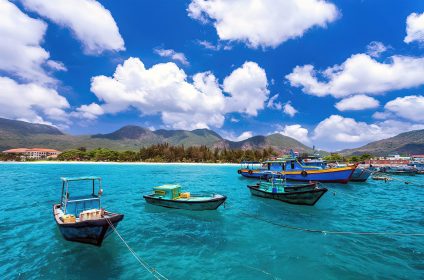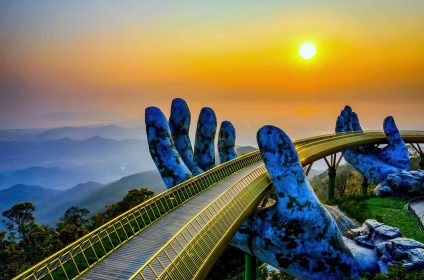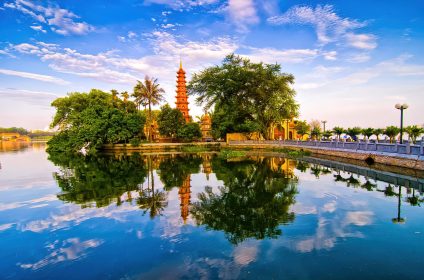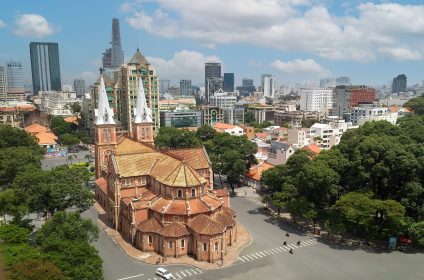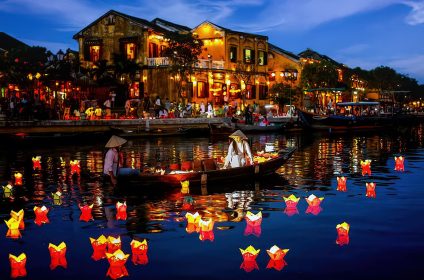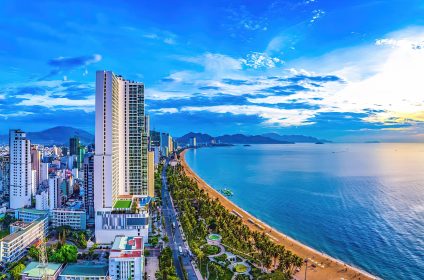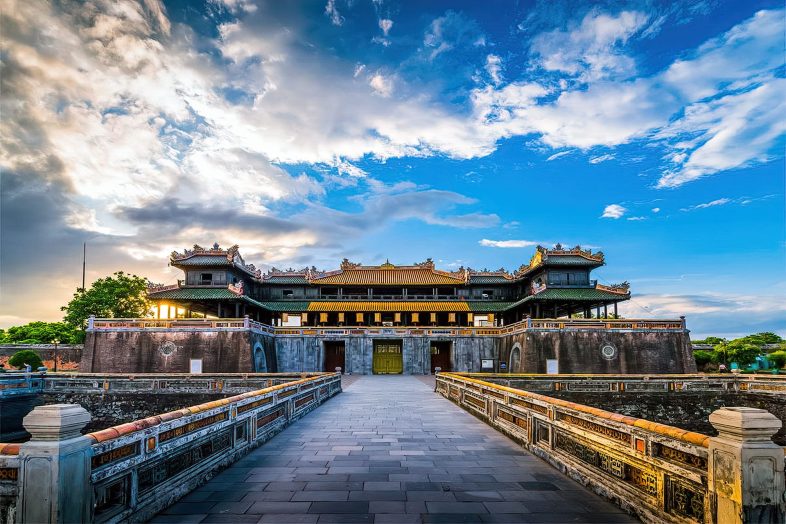
Hue
Hue is a city situated in the Thừa Thiên Huế province of central Vietnam. From 1738 to 1775, it was the capital of Đàng Trong and then from 1802 to 1945, it became the capital city of Vietnam under the regime of the Nguyen dynasty. During this period, Hue served as both an old imperial city and administrative capital for the country. Following this era during French Indochina period, Hue was an administrative seat for Annam protectorate. The complex consists of replicas of Royal Theater and Imperial City of Hue that contain palaces and shrines, Forbidden Purple City which was once an emperor’s dwelling; moat and high stone walls.
Hue teems with stories. There are many reasons besides its imperial legacy why kings chose wooded hills and fertile banks along rivers here to erect their feudal capitals during the reigns of the Nguyen Dynasty family’s kings. Hue has produced legends by creating delicious cuisine while mossy pagodas, art-deco palaces and lively markets dot its lush streets. The Perfume River glides through all this scenery setting a slow pace that everybody in town appears contented with.
Hue is easy to understand. The Perfume River (Hng Giang) is easily noticeable: on its north side are located older city together with citadel while at south – modern city with majority hotels and restaurants situated there; most part of riverside is a beautiful promenade and park decorated by strange sculptures; farther southwards, beyond Sài Gòn Bridge lies famous tombs.
You will not get bored in picturesque Vietnamese town called Hue because there are so many fun ways to spend your free time here! Romantic boat rides down Perfume River where one can see all known tourist attractions from above would be on top list for such tasks.Walks in parks lining both sides of river banks allow you not only have a stroll along, but also make picnics here.
Bach Ma National Park is very popular among nature lovers. In the park, aside from rare vegetation species, there are some beautiful national-style buildings and amazing waterfalls that can be reached through wonderful jungles. Tourists who like active lifestyle can take part in various activities such as cycling or trekking around the splendid city neighborhoods.
Hue will surprise shopaholics. The number of unique stores of this kind here is simply astonishing. Healing the Wounded Heart Shop offers many special products for sale including stylish accessories, amulets and other attractive souvenirs made by hand only once. DongBa is one of the most crowded street markets, where everything from European clothes to African spices can be bought at low prices. The market stays busy most days with lots of people coming just to eat authentic national food prepared according to traditional recipes.
In 2019 alone, about 4.2 million people visited the city and many old landmarks are still under reconstruction there.
Tourism In Hue
Among the many things that have put Hue in the limelight is its ancient structures which earned it a place among UNESCO World Heritage Sites. It was also where the Nguyen emperors had their homes, notably The Imperial City – a vast fortress on the northern bank of the perfumed river. Inside this complex were forbidden city gates, only accessible to Nguyens’ consorts, relatives and courtiers; any intruder to it was immediately executed on spot. Not much remains of that sacred space today but there are plans to rebuild it as a historical tourism site.
Further up toward Hue along the Perfume River are several other monuments such as tombs belonging to various emperors like Tu Duc, Khai Dinh and Minh Mang. And then there is Thien Mu Pagoda which is both the largest pagoda in town and its emblem.
On its south bank across Perfume River are some French-style buildings. Two examples would be Hue High School for Gifted Students and Hai Ba Trung High School; this latter one being Vietnam’s oldest school.
At 3 Le Truc Street can be found a collection of municipal antiques at Hu Museum of Royal Fine Arts.
From the city, you can take day tours to the Demilitarized Zone (DMZ) that lies around 70 kilometers (43 miles) north of Hue and has many American war remnants including Khe Sanh Combat Base, The Rockpile, Vinh Moc Tunnels and others as well as numerous tourist sites within this city.
Most hotels, bars and restaurants in Hue are located on these three streets: Pham Ngu Lao Street Chu Van An Street Vo Thi Sau Street which together form backpacker district of this city.
By November 2012, over 2.4 million people had visited Hue an increase by 24.6 percent from previous year during same period. Out of those tourists who visited Hue, approximately 803,000 more were international tourists. The city economy depends on the tourism industry but it has also affected the environment and natural resources in a negative way. Energy is widely consumed in tourism services such as transport, development of infrastructure, and production and consumption of goods. According to research by CDKN (Climate and Development Knowledge Network), “garden cottages” have potential for attracting more tourists with improved income levels. Although promoting garden houses has many positive impacts on environment, economics, society but this move gives way to additional low carbon initiatives.
Geography
The city is located a few miles away from the East Sea on the Perfume River in central Vietnam. It’s located approximately 1,100 km (680 mi) north of Ho Chi Minh City and 700 km (430 mi) south of Hanoi. The South China Sea and Quảng Điền District are in the north while Hương Thủy town borders it to the east and south; Phú Vang District is on its eastern side whereas Huong Trà town lies on its western frontage. From Danang, Hue is 105 km (65 mi), 14 km (8.7 mi) from Thuan An Seaport and Phu Bai International Airport, and 50 km (31 mi) from Chan May Port. Situated north of Hai Van Pass between two banks of the Perfume River. As at 2012, it was estimated that it had a population of 344,581 with an area spreading over 71.68 sq.mi(27.68 sq.km). Following territorial expansion as well as including non-residents’ number, total area would become equal to about an area around 265.99 sq.mi(102.70 sq.km), plus another 652,572 people by2021.
This city is situated in flat regions at low stages of both Bo rivers and Perfume; with elevations generally ranging from three to four meters above sea level (m.a.s.l.). The land is often flooded when Typhoon No1 rises near Truong Son mountain range or at their start point . Huong has average/medium annual rainfall levels with heavy rain sometimes experienced here/ there . For instance this plain area contains occasional small mountains such as Ngu Binh Mountainand Vong Canh Hill but mostly it is a very wide space without any obstacles on the way for cars/houses etc.;
Climate
Being that there is less than 60 millimeters (2.4 in) of rain between March and April, Hue has a tropical monsoon climate (Am) rather than tropical rainforest climate. The highest temperatures observed during the dry period which lasts from February to August are 35–40 °C (95–104 °F). They are characterized by off-seasons which are wet months starting from August and January respectively. Common rainy season temperature is around 20 °C (68 °F), since it can go as low as 9.5 °C (49.1 °F).
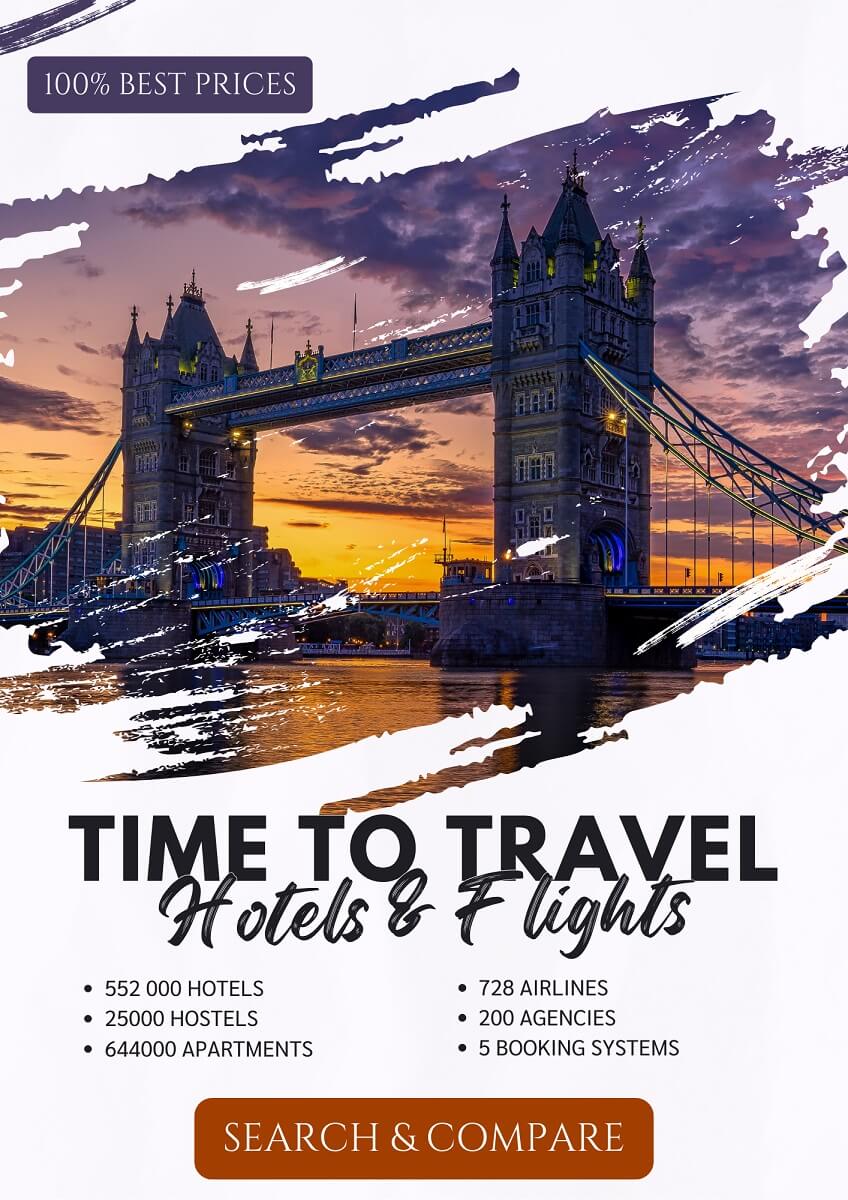
Hue - Info
Administrative code
License plates
Population
Area
Density
Time zone
Hue Travel Guide
Best Time To Visit Hue
- Mid-January-Apil: It is a spring of 22-25 degrees on average. The weather is dry and less humid from February to April which is most favorable for outdoor activities.
- May – August: The temperature in July averages between thirty and thirty-eight degrees Celsius. When the humidity is high, indoor activities such as visits to temples, museums, and traditional markets can be enjoyed during the dry season.
- Mid-August – September: As the autumn comes the rains started falling with temperatures ranging from 18 to 20 degrees centigrade. Those who don’t like crowds during busy periods may prefer this wet season.
How To Travel To Hue
There are daily flights between Ho Chi Minh City and Hanoi to and from the international “Phu Bai” (HUI) airport of Hue, but it is often interrupted by bad weather during the rainy season (Mid October – Mid December) in Vietnam. The three airlines which fly into “Phu Bai” airport are Vietnam Airlines, JetStar Pacific, and Vietjet.
The train runs every day to places like Da Nang (4 hours), Ho Chi Minh City, and Hanoi. To get to Hoi An from Da Nang you can take a taxi or motorbike ride, where you will cross Lang Co and Hai Van Pass.
Public buses connect with the main bus terminal from all major cities including frequent connections to Saigon and Hanoi among others. Frequently open tour buses make stops at Hue as part of their routine; these offer links to other places such as Hoi An or Da Nang southwards, and Hanoi in the north direction.
How To Travel Around Hue
Similarly to other Vietnamese cities, Hue is swarming with cyclos, motorbikes and a few taxis which are metered. Mostly taxi drivers are honest, but make sure they turn on the meter:the first two kilometers cost 15,000 dong while each kilometer thereafter costs an additional 11,500 dong.
Hue is crammed with cyclos, motorcycles and a few taxis with meters as in other Vietnamese towns. However most cab drivers can be trusted just make sure their meters are on: at first two kilometers for only 15 thousands dong then further kilometers for every kilometer at the rate of 11.5 thousand dongs.
Another option could be cycling since there are many bikes available for hire between 80,000-150,000 Dong ($4-$7 US) per day. This is cheap and interesting way to go around short distances. The majority of hotels in Hue offer foot access to restaurants and Citadel.
Attractions & Things To See In Hue
Hue is a Vietnamese city of great historical significance. This city was governed by the Nguyen Dynasty from 1802 and 1945. Many richly decorated temples and palaces were built in Hue at this time.The current city area consists of New Town, which includes the Old Town.
The historic neighborhood resembles a huge fortification with valuable monuments from earlier eras concealed behind its walls. The total number of buildings in the historic area is about three hundred; its distinct architectural composition has been duly recognized as an international treasure.
Perfume River, yet another remarkable symbol of this place, acts as a conditional boundary between old and new parts of Hue’s territory. Over numerous years, the town has managed to preserve its special magic and distinct national nature.
Activities & Things to do in Hue
An amazing experience awaits you on Hue’s ancient streets; wherever you turn, there are remarkable historical monuments. Here are the sepulchers of eight Nguyen emperors in the order of their reigns. These tombs are directly inside old palaces belonging to different monarchs. Each palace has a beautiful garden that is highly attractive. King Minh Mang burial place built during the first fifty years of the 19th century is among the most beautiful graves.
Among all landmarks, Royal Palace is a prominent one in Hue. A number of its halls have been made available for public visits today. The new emperor was inaugurated in this particular palace. The grounds contain privy council chambers, royal salons and several temples which tourists can visit at will.
Food & Restaurants in Hue
Among all Vietnamese central cities, Hue has the most evident contrast between it’s food and vegetarianism. Eating a vegetarian meal twice every month is an important part of their Buddhist religion. To accommodate these people, the city has many restaurants that only serve vegetables and fruits. Hue meals are small in size with elegant display which distinguishes it from other provincial cuisines in Vietnam; this can be traced back to its royal cuisine.
Hue Cuisine comprises both luxurious and popular rustic dishes. The royal food of Hue, which dates back centuries, is characterized by elegance and flavor. This kind of cuisine was originally meant for the Nguyen feudal lords’ who ruled over scores of emperors along with their numerous wives and concubines; therefore, it is made up of several tiny delicate courses.
Shopping in Hue
Hue is a handicraft center that sells such goods at surprisingly low prices.
The best place to shop in Hue, irrespective of the popularity of malls and plazas found here, are its many street markets.
Hue has become a shopping mecca for Vietnamese clothing, wooden carvings, conical hats, Sinh folk art and Zeng fabrics.
There are many types of shops in Hue from high-end boutiques, shopping centres for gamers or foodies or shopaholics to farmers’ markets full of sellers of spring roll or seafood or vegetable vendors.
Needlework is one of the oldest industries in Hue; there are several framed examples on show in some backpacker district’s shops.
Nightlife in Hue
Hue, the city of Vietnam, is famous for its heritage sites, religious shrines and Royal cuisine that boasts of over 1000 dishes. It also has world-class international nightlife. Hue’s Nightlife entails music night clubs and classy bars in five-star resorts, citadels adorned with dazzling lights, Jenga competitions, riverside evening markets vending souvenirs and Vietnamese spring rolls, magnificent bridges to view sunsets on and bistros to go after touring.
The City has seen a significant rise in noise level since the commencement of Hue’s Walking Street which is a positive development. This street is recommended highly by both international and local tourists who would like to taste street food from different parts of Hue. They can buy unique souvenirs here or visit traditional craft displays; otherwise they may just want to acquaint themselves with the local nightlife.
Festivals in Hue
Held every two years, the Hue Festival is an international cultural event which celebrates the irreplaceable legacy of Huế City. The first Hue Festival took place in 1992 and was originally named Vietnamese-French Festival. It was officially called “Hue Festival” in 2000.
The city’s cultural values are rejuvenated through many community-oriented programs both within and without. Such events as Night of the Palace, Nam Giao Worshiping Ceremony, Truyen Lo Ceremony, Ao Dai Festival, Sea festival, Kite Competition, Human Chess among others take place. Additionally, there are numerous traditional ceremonies that have been reorganised by the city as well as several traditional craft villages rehabilitated.
The diversity of nations participating in this great festival can be seen from various artistic performances during Hue Festival.

